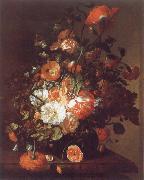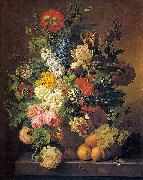Wholesale Oil Painting Reproductions No Minimum and Door to Door! |
|||||||||||
|
|
|||||||||||

|
|||||||||||
|
|
|
||||||||
All Rachel Ruysch Oil Paintings |
||||||||
|
|
||||||||
|
|
||||||||
|
Artist Introduction: Dutch
1664-1750
Rachel Ruysch (June 3, 1664 ?? Amsterdam, August 12, 1750) was a Dutch artist who specialized in still-life paintings of flowers.
She was born in The Hague, but moved to Amsterdam when she was three. Her father Frederik Ruysch, a famous anatomist, and botanist, was appointed a professor there. He gathered a huge collection of rarities in his house. She assisted her father decorating the prepared specimen in a liquor balsamicum with flowers and lace. At fifteen Ruysch was apprenticed to Willem van Aelst, a prominent Delft painter, known for his flower paintings. In 1693, she married a portrait painter, Juriaen Pool (1666-1745), with whom she had ten children. Her sister Pieternel was married to Jan Munnicks, a young man who drew flowers in the Hortus Botanicus Amsterdam.
In 1701 Ruysch was inducted into the painters' guild in The Hague. Several years later Ruysch was invited to work for the court in D??sseldorf and serve as court painter to Johann Wilhelm, Elector Palatine. She remained working for him and his wife from 1708 until the prince's death in 1716. Also Jan Weenix and Adriaen van der Werff were invited to deliver paintings, after Eglon van der Neer died. In 1723 she won the lottery. Ruysch kept painting for her prominent clients.
Ruysch lived eighty-five years and her dated works establish that she painted from the time she was a young woman until she was an octogenarian. About a hundred paintings by her are known. The background of the paintings are usually dark. Ruysch was also noted for her paintings of detailed and realistic crystal vases. |
||||||||
|
|
||||||||
|
Flower Still-Life Painting ID:: 40529 |
mk156
after 1700
Oil on canvs
75.5x60.7cm
|
|||||||
Height Width |
INS/CM Quality |
|||||||
|
X |
| |||||||
|
|
||||||||
All Jan Frans van Dael Oil Paintings |
||||||||
|
|
||||||||
|
|
||||||||
|
Artist Introduction: an excellent painter of fruit and flowers, was born at Antwerp in 1764, but went early to Paris and settled there. He was self-inatructed in art, but made such progress that he soon distinguished himself at the exhibitions, on one occasion obtaining the prize of 4000 francs, and on two others, the large gold medal. His style is in the manner of Van Huysum and Van Spaendonck, although he did not confine himself strictly to fruit and flowers, but painted other subjects, in which such objects might with propriety be introduced. Two of his pictures, which he painted for the Empress Josephine, represent 'An Offering to Flora,' and 'The Tomb of Julia'; the latter is now in the Louvre. His master-piece, known as 'La Croisee,' the fruit of three years' labour, was likewise purchased by the Empress Josephine, and is now in a private collection at Liege. He was also patronized by the Empress Marie Louise, who took one of his pictures with her to Parma. He died in Paris in 1840, and was buried in the cemetery of Pere Lachaise by the side of his friend Van Spaendonck. The Louvre has also by him three pictures of 'Flowers' and one of 'Fruit.' |
||||||||
|
|
||||||||
|
|
Flower Still-Life Painting ID:: 76190 |
Year = 1811
| Technique = Oil on canvas
| Dimensions = 108 x 82 cm
cyf |
||||||
Height Width |
INS/CM Quality |
|||||||
|
X |
| |||||||
|
|
||||||||
|
Prev Next
|
||||||||
|
|
||||||||
|
Related Paintings to Jan Frans van Dael :. |
||||||||
|
|
||||||||
|
CONTACT US |


